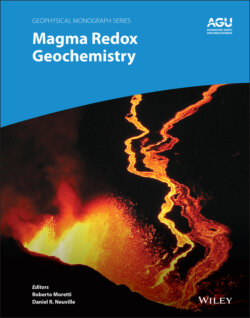Читать книгу Magma Redox Geochemistry - Группа авторов - Страница 17
1.3. CONCLUDING REMARKS AND PERSPECTIVES
ОглавлениеIn this short compendium we show the redox features in aqueous‐hydrothermal and igneous Earth. This allows the summarizing of the main redox features of a system, to show what we know of its equilibrium properties, but also what we do not know, especially for melts and magmas. We make a parallel between redox in magmas and redox in aqueous‐hydrothermal solutions and show that what really changes is the way redox variables are reported. It is better described in aqueous solutions, via E‐pH relations, because of the sound knowledge of acid–base properties, which allows good prediction of system reactivity with compositional changes and fosters applications in water‐based geochemistry and industrial practice (e.g. corrosion and hydrometallurgy).
Just as the measurement of pH is the key to studies of acid–base reactions, those of reactions involving the O2– ion in silicate melts naturally go through the measurement of pO2–, a magnitude similar to pH and playing an identical role. Same as a pH indicator electrode, a pO2– indicator electrode is the essential instrument to study acid–base properties of silicate melts. Technical challenges exist about this electrode as an instrument of analytical control operating directly in melts at high temperature and also as working assembly for anode reaction (inverse of Reaction 1.6). Besides, the low flux of oxide ion compared to cations is limited in melts and the lack of physical and chemical information about the molecular entities involved in the transport processes at each electrode and in the bulk of the electrolyte presents a conceptual difficulty for engineering the electrodes (Allanore et al., 2015).
Contrary to waters, in which E‐pH pairs can be measured in the field by probe electrodes and then directly compared to theoretical assessments, magma‐related samples do not offer the possibility to probe the conditions (temperature, pressure, gas composition, and also phase proportion) under which they equilibrated before becoming accessible to our observations. These conditions cannot be restored and must be calculated under strong assumptions, for example that glasses have preserved the same oxidation state of the melt from which they quenched. The impossibility to restore and measure the original system has surely contributed to overlooking the role played by acid–base properties and resulted in oxide‐based redox descriptions of melts and magmas centred around the thermodynamic concept of fO2, whose sole adoption was boosted by experimental petrology and the thermodynamic approach based on Ellingham’s diagrams in extractive metallurgy. The acid–base concept was progressively relegated to qualitative assessments (e.g., silicic for acidic and mafic for basic).
With the exception of volcanic gases, where fO2 (or related quantities such as fH2) can be directly measured with solid‐state O2 electrodes (Aiuppa et al., 2011 and references therein), the common practice, recently boosted by advancements in microbeam spectroscopic techniques (e.g., XANES) is to measure masses of elements in their different oxidation state and then relate such ratios to fO2 via approaches either based on thermodynamics or having a thermodynamic flavour to solve for the role of composition. Nevertheless, such approaches are valid only in limited compositional ranges and discharges on calculated fO2 the non‐ideal behaviours that are determined by speciation, hence by pO2–, and which cannot be reproduced by interaction parameters of oxide components (see Moretti, 2020).
These unpredictable non‐ideal behaviours are reflected by the shape of the excess Gibbs free energy of mixing, which is correctly reproduced only by ionic‐polymeric approaches to silicate melts mixing properties (e.g., Mao et al., 2006; Hillert et al., 1985; Ottonello and Moretti, 2004), which formalize the role of composition in establishing the relationships between polymerization and redox state in the melt. These approaches could be in perspective used to generate pO2– based phase diagrams, particularly logfO2‐pO2– diagrams analogous to logfO2‐pH ones reported in Figure 1.4 for aqueous‐hydrothermal solutions.
The joint description of acid–base properties and redox exchanges via predominance and stability diagrams would reduce ambiguities about the role of redox state and the “who controls what” dilemma: is fO2 a rather elusive parameter, or is it the bulk composition in the system that fixes the observed redox state? Besides, they would help in providing a more complete and formal redox description of geodynamic settings, in particular of how the redox state of magmas is a reflection of the source signature or the result of subsequent modifications due to magma evolution via partial melting, fractional crystallization, assimilation, or degassing (Carmichael, 1991; Burgisser and Scaillet, 2007; Gaillard et al., 2015; Moretti and Stefansson, 2020 and references therein) whose understanding would be beneficial at the scale of a single volcanic system to improve the forecasting of eruptions at both open‐conduit (generally basaltic) and closed‐conduit (generally andesitic) volcanoes via gas monitoring. Besides, this would better constrain the role of redox state on Earth’s evolution since its formation and accretion.
